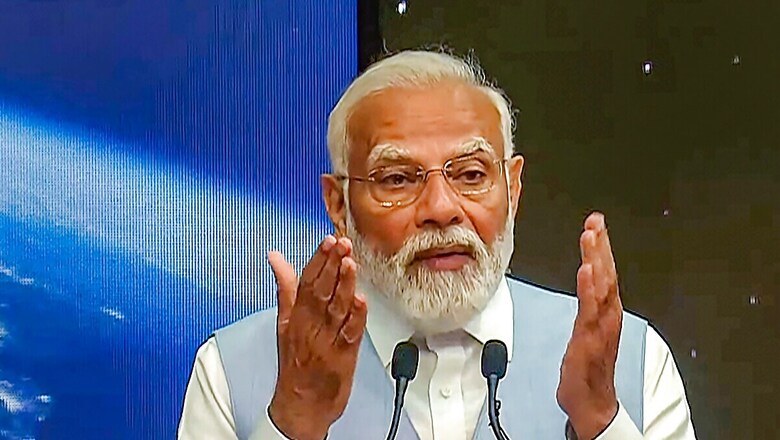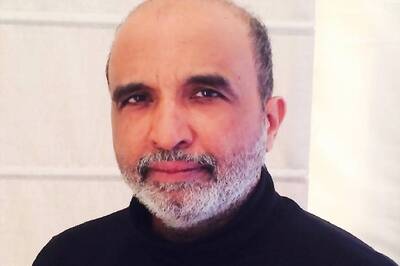
views
As the global strategic landscape goes through an unprecedented churn, there is no doubt that the Indo-Pacific has emerged into a new theatre of big-power geopolitical and geo-economic contestation, which is specifically underwritten by the Sino-American rivalry.
It is also an ideological contest, as China refuses to subscribe to the very definition of the ‘rule of law’ as envisaged by the West-led liberal order. It is crafting its own initiatives and prescriptions for the new world order, which is currently in an uncertain and painful transition.
For example, its troika of the Global Security Initiative (GSI), along with the Global Development Initiative (GDI), and the Global Culture or Civilizational Initiative (GCI), aim at redefining the underlying contours of global governance, along with its modified BRI (Belt and Road Initiative), which completed its 10th anniversary recently.
The Indo-Pacific region comprises 65 per cent of the world’s oceans, and countries throughout the region depend on the free movement of goods and people for their livelihoods. At the recently organised 7th Indian Ocean Summit in Perth by the India Foundation and Australian Foreign Ministry, the threats and assessments dictated a much greater and closer collaboration to ensure rule-based cooperation devoid of the hegemonistic acts and ambitions of some.
The health of the oceans and the judicious harnessing of the blue economy, especially by the littoral states and for the benefit of landlocked countries too, are important dimensions for a collaborative matrix. India’s Indo-Pacific Oceans Initiative (IPOI) and its expanded and comprehensive outreach will have much to offer.
It is very likely that the global order or disorder is heading towards a Cold War 2.0 matrix dotted by multipolarity, mini- and multilateralism, and strategic autonomy by many nations, especially in the Global South led by India.
As was witnessed during India’s recent presidencies at the G20, SCO, and BRICS, it has the capability and moral longing to find a way that is driven by dialogue, diplomacy, peace, and respect for the UN Charter while underscoring the template: ‘This is not an era of war’.
While it believes in multi-alignments, it has been averse to the ideas of an alliance mindset simply because the most populous country and soon to be the third largest economy with an exemplary civilisational heritage as well as a history behind it in the form of the Non-Alignment Movement (NAM) and the Voice of Global South cannot be subjugated and shackled in the gilded alliance architecture. But since India follows the 3M mantra of mutual respect, mutual sensitivity, and mutual interests within the ambit of Vasudhaiva Kutumbakam, it has excellent credentials to be a bridge builder amidst the divergence of opinions and interests in the international discourse, including in the Indo-Pacific.
Of course, India cannot compromise on the hegemonistic designs of some neighbours and territorial and sovereignty breaches by others, and it will give a fitting response to the misadventure on the ground or in the maritime domain.
India has always been a big maritime power. It is also a given that India is a resident power in the Indian Ocean and therefore has its strategic security and economic interests within the ambit of maritime focus.
Besides, since historic times, it has been a maritime and trading nation. The power of the oceans is supreme, but India considers them not as a personal fiefdom of a power but as a global common, and the availability of these to all nations and people is in accordance with international treaties and regulations adopted and accepted by the world community.
A large number of countries have come out with their own Indo-Pacific strategies as the competition becomes intense for power and resources. Most of these strategies are a mix of competing and converging interests.
In 1903, US Secretary of State John Hay expounded that “the Mediterranean is the ocean of the past, the Atlantic is the ocean of the present, and the Pacific is the ocean of the future”.
It appeared prophetic and well-proposed for strategists. Let’s add the Indian Ocean to it, and the picture is complete in a modern context. Late Japanese Prime Minister Shinzo Abe, while speaking at the Indian Parliament in April 2017, propounded the term Indo-Pacific with his ‘Confluence of the Seas’, stating, “The Pacific and the Indian Oceans are now bringing about a dynamic coupling as seas of freedom and prosperity, underling the concept of ‘Free and Open Indo-Pacific’.”
Freedom of navigation has come under stress due to Chinese intransigence and aggression in its periphery of interest and influence with several hotspots, including Taiwan and ASEAN.
Hence the US’ focus on the region as a major challenge and opportunity to exert its ideology of influence and counter and contain the Chinese intransigence in support of Taiwan despite them still proclaiming one China policy.
The roots of this competition are inherent in China breaking the US and western techno-economic barriers and the glass ceiling combined with its wolf-warrior diplomacy. Asia is the compulsive pivot for the new economic order, and India is a major player and a swing power.
Even though the Indo-Pacific is a natural area of strategic interest for India, it believes in the inclusivity of these global commons without excluding China, despite her own bilateral and border issues, even as Beijing refuses to abide by various agreements signed between the two countries.
Prime Minister Narendra Modi, while speaking at the Shangri-La Dialogue in 2018 in Singapore, re-emphasised and redefined the geographical scope of the concept, which extends from the Americas in the east to Africa in the west, with nearly eight sub-regions.
It encompasses all coastal countries, island nations, and the hinterland. He also spoke of the globally recognised principles and regulations of openness, inclusiveness, and non-exclusion—the centrality of ASEAN, which is an integral part of India’s Act East Policy. He underscored the need for non-targeting of specific parties, implying China, of course. But as the water flows down in the ocean, both Beijing and Moscow began to look at this concept and the ensuing QUAD (the US, Australia, Japan, and India), supposedly a security grouping, with suspicion and focused more on the US’s strategic Sino-centric containment policy. External Affairs Minister S Jaishankar, in his book Why Bharat Matters, calls the Quad as ‘Bharat Milap’ of the Ramayana fame. But we would have to be mindful of the ‘Kaikeyis’ of this world.
The Indian prime minister has often claimed that QUAD is a force for the global good. Since New Delhi did not subscribe to the containment idea per se or strategy of encirclement and wanted it to be participatory in accordance with the extant rules of Free and Open Indo-Pacific (FoIP) and freedom of navigation as against the practice of enforced suzerainty by big powers, it focused more on economic and other global challenges in which India can play a more constructive role.
These areas included combating the health impacts of Covid and other pandemics with warning and curative collaboration, i.e., health security for all; shared challenges in cyberspace, critical technologies, counter-terrorism, quality infrastructure development and investment; humanitarian assistance and disaster relief; as well as maritime domains.
Since the economic impacts of the pandemic and disruption of supply chains were highly destabilising, India, along with its partners, looked at the possibility of providing a partner in the alternate reliable global and value supply chains, as it had done during the height of the pandemic through the ‘Vaccine Maitri’ as against the vaccine apartheid. There is no doubt there will be competition, but a healthy one is always welcome. In this domain too, India sought to build bridges with an emphasis on dialogue, diplomacy, cooperation, and inclusion rather than conflict and negative and mutually destructive competition.
Russia is India’s singular special and privileged strategic partner, with Prime Minister Narendra Modi and President Putin personally invested in defining the contours and depths of this ‘beyond the hype’ relationship, which is amply clear from its expanse across strategic sectors including defence, security, space, and civil nuclear cooperation.
However, like Moscow, India also has to maintain and ensure its overall security through other consequential partnerships based on convergences and congruences; these could in fact help further intensify India-Russia relations across the bilateral, regional, and multilateral spectrums.
An understanding of India’s security needs is a major part of this. Russia need not look at India’s Indo-Pacific strategy from the US or Chinese lens and their strategic perspectives alone. It will do well to understand India’s unique stance and approach to global welfare while ensuring her own security.
Most analysts believe that India seems to have benefited from the Indo-Pacific enterprise and concept in several ways.
First, India has become the fulcrum of the Indo-Pacific as a result of its strategic location, economic strength, and capacity to become a player in global value and supply chains, which has helped it integrate into the Pacific unlike previous strategic, security, and economic groupings like the ASEAN Regional Forum and the East Asia Summit.
Second, it has provided India with viable options in so far as Chinese expansionist ambitions are concerned.
Third, it enables it to recapture its primacy in the maritime domain through collaborations with the navies of friendly countries for her safety, security, economy and defence beyond the Malabar exercises.
Fourth, it helps India project and serve global welfare through various regional and global initiatives. Finally, it also provides India with certain deterrence capabilities against disruptions while emerging as a major HADR power and provider that has been proven time and again. Moreover, trade and investment, health and food security, ICT and space, critical technologies and minerals and rare earths, technology and resilient infrastructure, climate change, and countering terrorism have become the cornerstones of its expanding footprints with each summit interaction and working level, as well as ministerial meetings.
Jaishankar maintains that the concept of the Indo-Pacific is a rejection of the spheres of influence and a reiteration that the world cannot be frozen for the benefit of a few. He further added that the Indo-Pacific was an indication of the future, not a throwback to the past, and only those harbouring a Cold War mindset will see such intentions.
No doubt, for many Western countries, the Dragon may always be in the room, but eventually cooperation and understanding will only navigate global welfare and avoid the mutually destructive syndrome as the two competing worldviews interact in an uncertain global landscape.
As New Delhi will be hosting the next QUAD Summit this year, India, with its policy of ‘One World, One Family, and One Future’ and strategic autonomy in action so well executed during her G20 presidency, is well placed to create and carry that trust and onerous responsibility, which could bridge the divide and mend geopolitical rifts in the Indo-Pacific region and beyond. Sanity in the international discourse is the last straw in the current disruptive international discourse.
The author is the former Indian Ambassador to Jordan, Libya and Malta and is currently a Distinguished Fellow with Vivekananda International Foundation. Views expressed in the above piece are personal and solely those of the author. They do not necessarily reflect News18’s views.




















Comments
0 comment